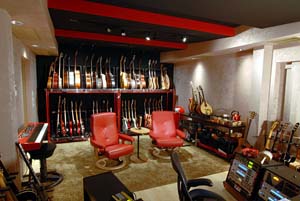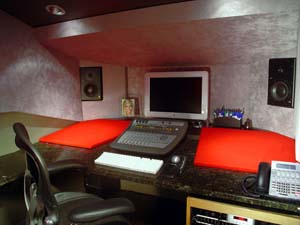Gaining Clarity Through PhantomFocus: An Acoustician’s Room-Tuning Enhancement Protocol
Studio designer and acoustician Carl Tatz has developed his proprietary PhantomFocus System™ on the premise that “great speakers in a great room do not equal great monitoring.”
The PhantomFocus System is Tatz’s “tuning standard for studio monitoring.” It is a turnkey solution for studios willing to go the extra mile to achieve a higher level of monitoring accuracy in their control room environment. Using a combination of proprietary protocols, hardware and software, Tatz can optimize monitor systems in any kind of room, addressing typical problems that occur in every control room that acoustic treatments, i.e. bass traps, cannot solve.
“Most of my clients complain about the low frequencies,” Tatz informs. “If you setup your speakers relatively well, you can reasonably get from about 100Hz on up. But below 100Hz, it’s a nightmare.”
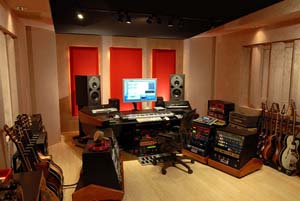
Willisoundz II: the second studio designed and built by Carl Tatz for guitar player and producer, John Willis, featuring the PhantomFocus System™ Four – Near Field.
The reality, according to Tatz, is that even though some nearfield speakers are designed to go down as low as 40Hz, in practice, he contends those low frequencies will rarely, if ever, be heard. And this, he says, applies in rooms of all shapes and sizes as a result of frequency cancellations caused by the boundary effects of floor, walls, ceiling and console bounces.
“I did a test in a famous studio with five different pairs of monitors on the meter bridge and tested them all and not one of them went below 100 or 90Hz,” he cites.
“After that, they just rolled off sharply. And all of these speakers are spec’d to go down to 40Hz. It’s very typical to get console bounce and the bounce off the front wall. High-end engineers will talk about how they’re hearing a nuance at 50Hz when they’re not hearing anything! It’s like the Emperor’s New Clothes. So then they’ll add a subwoofer to extend the low frequency performance, and then they just have this big bump someplace with huge dips.”
As a studio designer, Tatz will incorporate PhantomFocus Systems into his own room designs, but he will also implement systems in existing rooms — from asymmetrical bedroom studios to world-class, large-scale control rooms — and tune any kind of speakers (near and mid-field, mains) and combination of speakers.
Studios owned by Rascall Flatts, Sheryl Crow, John Willis, The Grand Old Opry, The Ryman Auditorium, Andy Dodd and Adam Watts, Beaird Music Group, Bob Bullock and Verge Entertainment Company are among the many rooms in Nashville featuring PhantomFocus Systems.
HEARING IS BELIEVING: THE PHANTOMFOCUS GUARANTEE
Although Tatz assures that he “bats a thousand” with PhantomFocus Systems, that his clients flip out when they hear it for the first time, he is also quick to acknowledge an important truth: “You could mix in an empty swimming pool and eventually your mind-ear figures it out,” he assures. “Otherwise how would great-sounding records be made? You learn the room and then there’s less and less guessing. But, you do have to learn your room.”
The PhantomFocus System promises to dramatically reduce the guesswork and therefore learning curve for a mixer. “One of my recent clients, Ed Seay, has been mixing in pro studios for many years,” says Tatz, “And his reaction upon sitting in his new PhantomFocus-tuned control room was ‘I deserve this!’
“Seay recently moved into the old Warner Brothers studio in Nashville, which is very small — the control room is probably 12 x 17ft — and with the PhantomFocus system, he says he can hear more than he’s ever heard in his life. It can be pretty breathtaking when people experience it for the first time.”
Tatz is also quick to point out that part of what the PhantomFocus System allows him to accomplish is simply — “ just setting monitors up correctly as the fathers of stereo wanted us to,” he explains, “without inserting some sort of exotic psychoacoustic DSP program.”
“I come in and take full responsibility that what I do is going to work,” Tatz adds. “I can 100% guarantee the client will have a world-class sweet-spot.”
As an extreme example of this guarantee, Tatz refers to another of his Nashville small-room clients, a studio known as “The Cockpit.”
“This is what I call the ‘worst room in the world,’ Tatz describes. “It’s 7ft wide x 9ft deep and the front wall is 4 ft high and slants up. And with the PhantomFocus system, that little room is better than probably 95% of the studios in the world as far as monitoring accuracy!”
Currently, Tatz is working on producer/engineer John Merchant’s studio, in which he’s implementing a Dual PhantomFocus system for Merchant’s nearfields and huge, double TAD 15” horn mains.
There are four basic configurations of PhantomFocus Systems based on the “desired sonic muscle” and cubic footage of the control room, i.e. PFS One: 6,000 peak Watts for control rooms up to 27,000 cubic feet, and at the other end of the spectrum, PFS Four: 1,000 peak Watts for control rooms up to 5,500 cubic feet. Any one of the systems (outlined here) can be implemented in a nearfield, midfield, main or Dual PhantomFocus configuration.
FINDING YOUR SWEET SPOT: ACOUSTIC DESIGNS, EXPERIMENTATION & SPEAKER SHOOTOUTS
As turnkey solutions, every PhantomFocus System configuration involves some level of acoustic consultation if not custom acoustic designs. In cases where he’s not designing the room acoustics himself, Tatz gathers as much information as possible on the room and makes acoustic recommendations where necessary for the more raw spaces prior to traveling to the site to implement the PhantomFocus System over, typically, a two-day process.
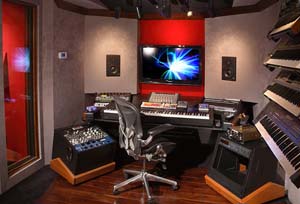
The Wine Cellar is a compact production suite within Jay DeMarcus’s (Rascall Flatts) personal recording complex known as The Grip. The rear wall is a wide band axial mode absorber that attenuates frequencies down to 50Hz. The PhantomFocus System™ Four – Near Field’s subwoofer system is mounted in the upper front corners of the control room to allow the Argosy desk to fit in place.
The entry-level price point for a PhantomFocus System Four is approximately $8K and ostensibly saves clients from investing in what Tatz refers to as what can be “hocus pocus acoustic trapping.”
“Basically, sometimes it’s just acoustically incorrect to build a big bass trap, or sometimes it’s simply not in the budget,” says Tatz. “If I’m working with a client who has a home studio, I will make sure the first reflections are taken care of first. I’ll have them do some simple acoustic treatments themselves — i.e. build or buy some panels to grab the first reflections on the left, right and back walls, and a cloud to grab those first reflections on the ceiling — and then, I’ll come in and I’ll calculate the room to get an idea of what’s going on modally.
“But, in a really small room, the boundary effects are just as strong if not stronger than the modes.”
This is where the PhantomFocus System comes in. “My on site process can be somewhat experimental and very tedious, not unlike mixing a record,” Tatz notes. “The first day is the rhythm section, getting the basics down — we set up the speakers at the proprietary angle, getting them in the right position, getting the engineer in the right position, establishing the sweet-spot, with the apex crossing over in back of the engineer’s head.
“Once I have the imaging down, then on the second day, I’ll come in with the digital processor and play with phasing in the subwoofer system so that the 5” drivers sound like they’re putting out 20Hz. Then there’s phase alignment and equalization and playing with crossovers. And there’s a pocket I listen for just like in a mix. I have a proprietary curve that I use. When I have the client sit in the seat, they can’t believe it! Sometimes we’ll continue to tweak a bit, to accommodate personal tastes on the low end or midrange.”
Locally, Tatz implemented a Dual PhantomFocus system in the centerpiece recording/mixing control room within the WWE facility in Stamford, CT. This is an impressive, large-scale control room that’s home to WWE chief audio engineer and composer Jim Johnston.
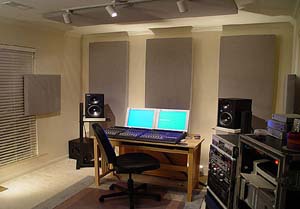
The Dining Room: A small, unused dining room in Bob Bullock's (Shania Twain) home has been transformed with a PhantomFocus System Four – Near Field.
“Jim’s got more gear than I’ve ever seen in any commercial studio, including two 9-foot concert grand pianos,” Tatz remarks.
“And this is a beautiful Russ Berger room, but Jim had some Dynaudio C4s that were just sitting in a corner and NS10s and he just wasn’t happy with it. We did a dual-PhantomFocus system with him and his final comment was ‘as advertised,’ which is all I need to hear.”
Although he will often implement a client’s existing monitors, Tatz will also make speaker recommendations if requested to and encourage his clients to try out a few speaker sets in the process.
“I’m doing a room now and the client loved the Dynaudio M1s and Bryston 4B-SST amp combo, which I demo’d for him inside a studio in Nashville, but they were a little out of his price-league, so I suggested the Focal Twin 6Bs, which are along those lines,” says Tatz. “I didn’t have any for him to hear, but I got them from a friend in town. I can usually facilitate demos with the speakers of interest.”
PhantomFocus Systems are always a totally custom job, and seem to be flexible in how they’re implemented and to what degree Tatz is involved as an acoustic designer.
“I’m doing a job right now where we’re splitting up the two days — doing the setup tomorrow and then the tuning when the engineer gets back into town next week,” he explains. “This is a bizarre, wacky room, but I find that particularly exciting because the difference I’ll be able to make is so dramatic. He has no low end at all — it’s just all being cancelled out. And when I’m through, it will be stunning.”
For more on Carl Tatz Design and the PhantomFocus Systems, visit http://www.carltatzdesign.com.
Please note: When you buy products through links on this page, we may earn an affiliate commission.







